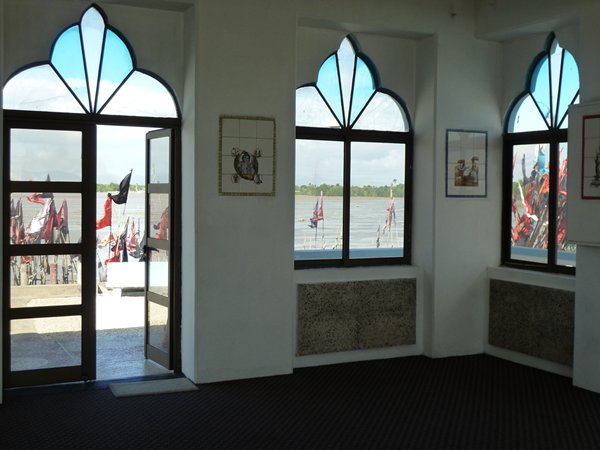Exploring Trinidad- Pitch Lake, Temple on the Sea and Caroni Swamp

Sy-tucanon
Philip Fearnhead
Fri 1 Feb 2013 01:40
|
1st February 2013
Although we had taken time out for a visit to Port of Spain the previous
weekend, and been greatly impressed by both the number and quality of pan
(steel) bands preparing for Carnival, this was our first serious day of
sightseeing. We were pleased to be joined by David and Hella Bickle.
David was the GP on Barra Island in the Hebrides for many years before his
retirement, in preparation for which they had had build a 50ft Wharram designed
catamaran in Thailand. This is a relatively low tech/low stress vessel
using ropes in place of wires and wood in place of plastic, but nonetheless has
a proven record of ocean sailing and is an antidote to mainstream plastic boats
with a small but loyal following. David and Hella had already sailed their
boat to the UK from Thailand and subsequently crossed the Atlantic to
Trinidad.
Our first stop of the day was the Pitch Lake at Brea in the south west of
Trinidad. This is one of only three known pitch lakes where oil has seeped to
the surface and over the millennia thickened to form a thick tar (asphalt) as
the more volatile components evaporated. The Brea lake covers an area of
some 89 acres, but the underlying structure extends for tens of miles. The
pitch is “mined” by bulldozers which first strip the top few inches of sun dried
material and then scoop up 300 tons per day of the thick pitch below.
Although extremely viscous, the material slowly oozes back towards a level
surface. It is possible to walk over the lake on its hard “skin”, but a
guide is necessary to avoid stepping into the sticky soft tar pools which are
reluctant to release any unfortunates who stray into them. Roads and
houses in the surrounding area are continually “flowing” if not on level
ground. It seemed appropriate, therefore to find dozens of vultures on the
lake, in contrast to those tourists who apparently find bathing in the
sulphurous pools beneficial for a number of minor complaints. Ospreys are
also common and apparently often drop their fish on the hard surface and wait
for the fish to die in the sun before consuming them.
Our next stop was the Temple on the Sea, a Hindu Temple built by an
indentured labourer on mud flats 100 metres or so from the shore. He was
forbidden to build on dry land which was Crown property at the time. Indentured
labourers were brought to Trinidad after the abolition of slavery when the newly
freed African slaves were reluctant to continue working the cane fields.
Apparently our man was driven more by passion than engineering and it took
many years of labour before he finally completed a structure which could
withstand the sea’s continual eroding influence and is, indeed, a significant
achievement for a man with few resources. Today it still sports
traditional prayer flags and statues of deities, while occupying a commanding
view of the surrounding sea and coast.
Highlight of the day was our late afternoon visit to the Caroni Nature
Reserve on Trinidad’s west coast. This is a Mangrove swamp covering many
square miles which are inhabited by creatures as varied as Boa constrictors (a
small species, typically 6-7 feet long), tree climbing crabs, four-eyed fish
(mud skippers), caimans and many varieties of birds. The highlight was the sight
of hundreds of Red Ibis (Trinidad’s national bird) gathering to roost in the
mangrove islands at dusk. This is an astonishing flood of waves of scarlet
birds descending on the green foliage illuminated by the setting sun, leaving
the mangroves looking as though they had been decorated for Christmas.
Interspersed with the Ibis are smaller numbers of white Egrets and even smaller
numbers of Blue Herons. To see this sight required joining a guided boat,
which was very worthwhile.
|

















